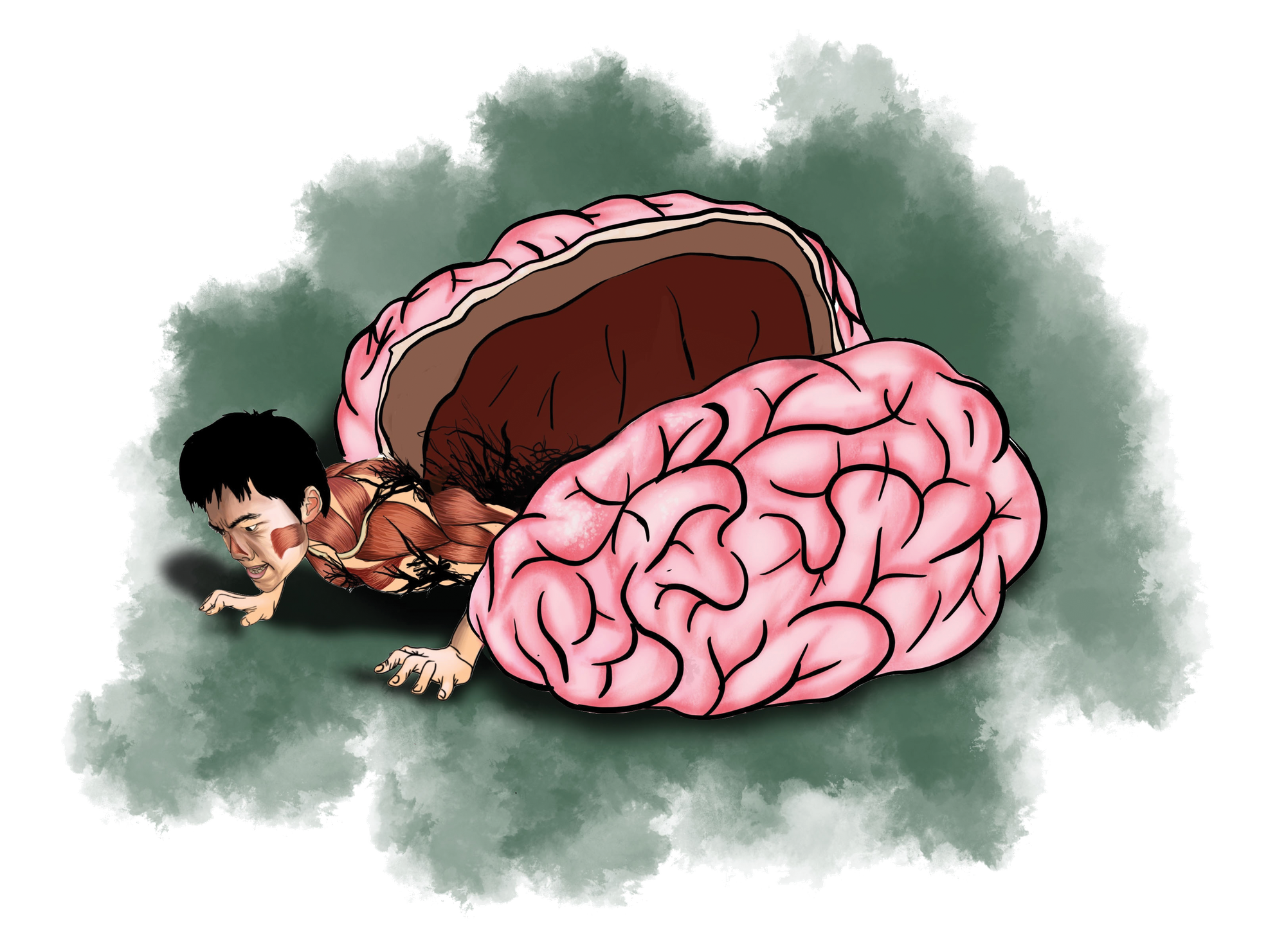For centuries, many have wrestled with what the “self” really is. As a species, we have come to the conclusion that a fundamental part of being human is having a sense of self. We have an innate ability to reflect on our experiences and to learn from them. It is universally understood that every person has an ego or a self that allows for the unique experience of being human. Ultimately, understanding the self is a crucial part of understanding the human experience, and even certain brain disorders as well. Soon we may be able to scientifically pinpoint the physical basis that allows us to know who we are. Recently, researchers have been able to determine a complex set of brain structures that govern self-related thoughts, bringing us closer to understanding how our human ego is physically represented. This network of brain structures is called the Default Mode Network (DMN). The DMN is a uniquely connected network, and its connectivity, as well as its cognitive functions, could help us determine what the self is.
The DMN is a set of interconnected brain structures from the frontal to the parietal lobes that play a major role in many self-referential and introspective processes. In order to measure the location, connectivity, and activity of these structures, researchers commonly use functional magnetic resonance imaging (fMRI). This technique uses a machine that captures a map of the brain, similar to MRI, but it measures the blood oxygen levels in the brain, resulting in a blood oxygen level dependent (BOLD) signal. When a specific part of the brain is being used, more oxygenated blood flows to that area, indicating that there is higher neuronal activity [1]. In order to analyze the DMN, researchers use resting state fMRI, which analyzes brain activity when people are at rest, or not engaged in any goal-directed cognitive activity.
Using resting state fMRI studies, researchers were able to visually determine that areas in the frontal, temporal, and parietal lobes are all involved in DMN activity [2]. They found that these structures are functionally connected, meaning these areas are not physically connected, but are temporally connected. Structures are temporally connected when they tend to activate at the same time Studies show that when our brains are at rest, the BOLD signals spontaneously oscillate constantly at a very low frequency in the DMN. This is characteristic of interconnected brain structures that share functional properties, coined low frequency resting state networks, including the DMN [1]. The low frequency oscillations are what temporally bind anatomically separate brain structures and drives high frequency activity in these separate regions. This functional connectivity and coordination between low frequency oscillations and high frequency activity, are what allows for constant information processing in different areas of the brain, which appears to be a common necessity in many higher cognitive processes, such as memory [3]. It’s like computers all connected to the same wifi, the wifi connection acts as the low frequency oscillations that connect the computers, and the computers can operate different programs like the high frequency oscillations in each brain structure.
Analyzing resting state fMRI gives insight into the anatomical location of the DMN and how its individual structures are connected to each other. However, there are other low frequency resting state networks that show the exact same low frequency oscillations at rest, but in different brain regions than the DMN. So how is the DMN unique? Recall that the DMN is referred to as the “default mode” network because it is most active when one is in a “default” state, unlike other low frequency resting state networks. The default aspect of the DMN is best illustrated when observing how it functions with another network called the task-positive network. These two networks are so strongly anti-correlated, that many researchers believe that their functions are opposites of each other [1]. This task-positive network is active when a person is engaged in goal-directed tasks, as opposed to the DMN, which is active at rest. These two networks are low frequency resting state networks, so both are constantly active, but the degree of activity depends on if the person is engaged in a task. When the task-positive network increases in activity, a person is engaged in a goal-directed task, indicating increased extrospective thought. At the same time, the DMN decreases in activity, but doesn’t deactivate completely and vice-versa [4]. However, the converse is also true, meaning that when at rest the DMN increases in activity while the task-positive network decreases in activity, indicating increased introspective thought, while the task-positive network decreases in activity. Because the DMN and task-positive network cannot increase in activity at the same time, their functions are thought to have opposite functions, which are introspective and extrospective thought [1]. Studies like these imply that a person’s default mode is introspection, and not engaging in any goal-directed task.
Does this “default mode” of a person come close to representing the self? When researchers discovered that the DMN is most active when a person engages in introspective thought, they began to test for the kinds of thoughts that engage the DMN the most. The general introspective thought process is a person’s stream of consciousness: Thinking about old friends, envisioning possibilities, imagining worlds beyond Earth, and generally relating the world to oneself through a constant inner monologue. Initially, researchers tried to see if these daydreaming tendencies were linked with the DMN at all. It turns out that if a person daydreams often, their DMN was more active than people who don’t daydream [2]. Researchers have investigated the specific types of thoughts that constitute daydreaming and how they activate the DMN. There are two main sources of evidence that help point to the main function of the DMN: tasks that increase activity in the DMN, and the cognitive functions of specific anatomical subsystems within the DMN.
Researchers ultimately found three main operations that increase the activity of the DMN: autobiographical memory, theory of mind, and envisioning the future [2]. To test if autobiographical memory increases DMN activity, participants were asked to remember events from their past, like their first day of highschool, or a time they failed a test. When people actively remembered and visualized these types of memories, the majority of the DMN was activated. The second task was to test the theory of mind, which places oneself into the perspectives of others. It also involves understanding one’s own internal mental states and relating them to others in order to understand other people’s emotions, intentions, and beliefs. Participants were instructed to read a story that requires them to understand another person’s perspective, and essentially put themselves in someone else’s shoes. When thinking of how other people are feeling or thinking, the areas of the brain that are active significantly overlap with the DMN. It is also interesting to note that when participants think about how other people physically feel, or when they think about others’ appearances, the DMN is not active [2]. This further supports the theory that the DMN has little to do with bodily states, but more about introspective cognition. The third task was to test envisioning the future in relation to one’s self, such as picturing oneself a week from now eating a sandwich on a bench in the park. When participants were asked to picture themselves in future scenarios, many had detailed personal connections to their responses. Yet again, the regions that were active in this task fell within the DMN [2]. All of these tasks concerned some sort of self-relevant thought, leading to the conclusion that the DMN is intimately related to the representation of self in the brain. As it is impossible to perform autobiographical memory, theory of mind, and envisioning the future tasks without referencing the self, researchers felt there must exist a relationship between them. When considering the relationship between theory of mind, envisioning the future, and autobiographical memory, coupled with evidence of DMN activity, it seems that the commonality is the concept of self.

There are two main subsystems that have definitive cognitive functions that provide further evidence that the DMN does participate in these self-related processes: The memory subsystem and the self-relevant simulation subsystem [2]. These two systems are anatomically separate, but are functionally connected in the DMN through low frequency oscillations [2]. The memory subsystem is thought to be the foundation for associating and relating information from memory, and to play a crucial role in standard memory retrieval, . The self-relevant simulation subsystem is thought to be active when a person is imagining scenarios about themselves, or that include people that are similar to themselves. For example, the subsystem is active when making judgements about people that have similar political views, but making the same judgements about people who had different views did not activate the subsystem [2]. The self-relevant simulation subsystem is also active when picturing oneself in specific scenarios, but not active when asked to picture strangers in the same situations. Since the DMN has many functions that require both memory retrieval and self-relevant simulation, it is reasonable that both of these subsystems are anatomically within the DMN. Both of these subsystems work together in the DMN, and certain tasks pull greatly from both. Autobiographical memory and envisioning the future activate both subsystems, because both memory and simulation are needed. However, theory of mind tasks activate the self-relevant simulation subsystem, but only minimally activate the memory subsystem [2]. One possible explanation is that the memory subsystem is only active when information about the past is needed, meaning one can still participate in theory of mind tasks without calling upon memory [2]. Because there are specific self-related tasks that activate the DMN, and the memory and simulation subsystems exist within the DMN, researchers have concluded that the main function of the DMN is self-relevant thought.
Researchers have further explored what other types of thought reside in the category of self-relevant thought, and if these thoughts would also activate the DMN. A study has found that when asked to evaluate other people’s moral decisions, the DMN was not activated. However, when the question was framed as, “Would it be morally acceptable for you to…?” the DMN was activated [2]. It seems that yet again the DMN is active only in situations framed towards the self. There could very well be more self-referential experiences that activate the DMN, including feelings of guilt, pride, or shame. Using the DMN as a physical indicator of the ego, scientists may be able to research more deeply into human experiences.
Recent research has been progressing towards using the self-referential nature of the DMN to gain insight into brain disorders that have to do with cognitive dysfunction. Many of these disorders prey on some component that the DMN activates, including theory of mind, memory, and internal thought. Some of these disorders include Alzheimer’s disease, autism, schizophrenia, and depression. Autism is characterized by the decreased ability to have social interactions and communicate. People with this disorder have difficulty performing theory of mind tasks, which accounts for their impaired social interactions [2]. This decreased ability follows from developmental disruptions in the DMN, which may cause the DMN to be weakly functionally connected. Alzheimer’s, however, is characterized by initial memory loss preceding decreased executive function. Studies have shown that patients with Alzheimer’s have lower metabolism in the DMN, and increased atrophy in the DMN [2]. These symptoms all occur in early stages of Alzheimer’s, suggesting that early disruption of the DMN is a strong indicator for the disease. Atrophy leads to formation of plaques that are left in the brain and appear in the anatomical location of the DMN. Dysregulation of the DMN is implicated in other psychological disorders, including schizophrenia and depression, both of which show increased DMN activity. Schizophrenia is characterized by altered perceptions of reality, which include hallucinations and delusions. People with this disorder have an overactive DMN and have trouble switching between networks that deal with their internal world, like the DMN, and the external world, like the task-positive network. Researchers hypothesize that people with schizophrenia mix their inner thoughts with thoughts about the external world, which results in delusion and hallucination [2]. Similarly, the DMN is more active in people with depression, which is an illness characterized by increased depressed thoughts. Moreover, the amount of DMN activity also correlates with depression severity [5]. Although abnormal DMN morphology and activity may not be the direct cause of these brain disorders, investigating the DMN further could lead to advances in determining a physical basis for behaviorally based brain disorders.
Recent research has shown that the DMN can continue to provide physical insight into illnesses that are typically diagnosed behaviorally. Additionally, researchers may be able to construct a definition of the self that is grounded physiologically. Further research into the activation of the DMN needs to be done to delve deeper into what consciousness, self, and other defining human qualities really are. Additionally, researching the DMN will help scientists discover the neurological underpinnings of the self. The discovery and research of the DMN generates intriguing questions as to what the self is. Is the self simply a mechanism for humans to reflect and improve? Or could the self be an abstract concept that the brain can only reflect upon? Figuring out how the brain represents and creates our sense of self could be one of the most important steps in truly understanding who we are, and what makes us human.

References
- Broyd, S. J., Demanuele, C., Debener, S., Helps, S. K., James, C. J., & Sonuga-Barke, E. J. (2009). Default-mode brain dysfunction in mental disorders: A systematic review. Neuroscience & Biobehavioral Reviews , 33 (3), 279–296. doi: 10.1016/j.neubiorev.2008.09.002
- Buckner, R. L., Andrews-Hanna, J. R., & Schacter, D. L. (2008). The Brains Default Network. Annals of the New York Academy of Sciences , 1124 (1), 1–38. doi: 10.1196/annals.1440.011
- Heuvel, M. P. V. D., & Pol, H. E. H. (2010). Exploring the brain network: A review on resting-state fMRI functional connectivity. European Neuropsychopharmacology , 20 (8), 519–534. doi: 10.1016/j.euroneuro.2010.03.008
- Raichle, M. E., Macleod, A. M., Snyder, A. Z., Powers, W. J., Gusnard, D. A., & Shulman, G. L. (2001). A default mode of brain function. Proceedings of the National Academy of Sciences , 98 (2), 676–682. doi: 10.1073/pnas.98.2.676
- Sheline, Y. I., Barch, D. M., Price, J. L., Rundle, M. M., Vaishnavi, S. N., Snyder, A. Z., … Raichle, M. E. (2009). The default mode network and self-referential processes in depression. Proceedings of the National Academy of Sciences , 106 (6), 1942–1947. doi: 10.1073/pnas.0812686106
- Sonuga-Barke, E. J., & Castellanos, F. X. (2007). Spontaneous attentional fluctuations in impaired states and pathological conditions: A neurobiological hypothesis. Neuroscience & Biobehavioral Reviews , 31 (7), 977–986. doi: 10.1016/j.neubiorev.2007.02.005
